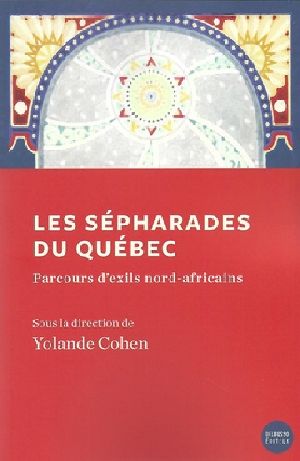Yolande Cohen
Les Sépharades du Québec: Parcours d’exils nord-africains
Montreal, Del Busso Editeur, 2017. ISBN: 978-2—924719-17-6
Reviewed by Ira Robinson*
Among the most significant migrations of Jews in the past hundred years is that of the Jewish communities of the Maghreb in the mid-twentieth century because of the creation of the State of Israel and the independence of the countries of North Africa. Jews leaving the Maghreb made significant contributions to the social and religious ambiance of Jewish communities to which they migrated, notably in Israel, France, and Canada.
Yolande Cohen, a historian at l’Université du Québec à Montréal, has published extensively on the Moroccan Jewish community in Canada, often called Sephardic [Sépharade]. She has now edited a volume of essays, Les Sépharades du Québec: Parcours d’exils nord-africains, that presents a reasonably comprehensive picture of the North African Jewish (mainly Moroccan) community of Montréal and its complex relationship with the larger Jewish community of that city.
North African Jews coming to Montréal, either directly from the Maghreb or from other countries (mainly Israel and France), arrived in a place whose Jewish community was overwhelmingly of Ashkenazic heritage and English-speaking. For the established Jews of Montréal, therefore, the North African Sephardim may have shared common religious roots with them, but differed significantly in their language, culture, and foodways. On the other hand, these same Moroccan Jews, because nearly all of them had acquired the French language, had something important in common with the francophone majority population in Montréal and Québec, and therefore felt “at home” in Québec in a way that the established Jewish community, overwhelmingly educated in English, could not.
The articles in Les Sépharades du Québec: Parcours d’exils nord-africains shine a spotlight on the process whereby, from the 1950s to the present, the Sephardic Jewish community has negotiated its place within the larger, Ashkenazic-dominated Jewish community of Montréal as well as in relation to the political realities of Québec. Yolande Cohen and Martin Messika begin the book with an “Introduction” that ably sets the stage for the more detailed contributions to come with respect to the broad picture of North African Jewish migrations, with special attention to the Canadian experience.
Antoine Burgard’s article looks at the treatment of the Sephardic community in Montréal from the demographic perspective. In a Montréal Jewish community whose numbers have considerably diminished since the 1970s, the North African Jewish community, over 20,000 strong, has become a segment of major importance. Martin Messika and Yolande Cohen contribute an article that compares North African Jews in Paris and in Montréal, utilizing information gained from Jewish marriage records in both cities to illuminate the social and occupational structure of these communities. Christine Chevalier-Caron looks at the educational and cultural influence of the Alliance Israȅlite Universelle in North Africa on the educational choices of the Montréal Sephardic community with special attention to its flagship school, l’Ecole Maȉmonide.
Olivier Bérubé-Sasseville ably utilizes a series of in-depth interviews of community members to draw the reader’s attention to some key issues in the ongoing story of the North African Jewish community becoming “at home” in Montréal. Of special importance is the community’s dynamic (and at times fraught) relationship with the Ashkenazic Jewish community. Steven Lapidus concentrates on the religious expressions of the Montréal Sephardic community, and highlights some significant intra-communal tensions between its traditional and ḥaredi elements. Finally, Phillipe Néméh-Nombré examines the employment history of Moroccan-Jewish women immigrants to Montréal from the beginnings of the North African Jewish migration in the 1950s through the 1970s.
It is clear that no volume of collected essays can present all relevant aspects of the complex communal dynamics of the Moroccan Jews in Québec in the past seventy years. Nonetheless, Yolande Cohen’s volume, taken as a whole, presents a generally comprehensive, clear, and accurate portrait of the Sephardic community both in its Québec milieu as well as in the comparative context of the multinational North African Jewish diaspora.
* Ira Robinson is Professor of Judaic Studies in the Department of Religions and Cultures, Concordia University, Montréal, Canada.

